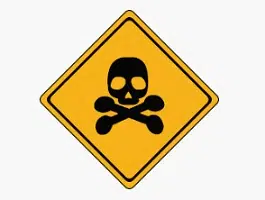 The adjective toxic is used to describe something that has poison or that can cause poisoning. A poison, meanwhile, is a substance that causes damage to health and even death when a living being comes into contact with it.
The adjective toxic is used to describe something that has poison or that can cause poisoning. A poison, meanwhile, is a substance that causes damage to health and even death when a living being comes into contact with it.
The term toxic can also be used as a noun. The greater the effectiveness of a poison, the greater its toxicity : this notion refers to the level of damage it can cause to a person, an animal or a plant.
Toxic substances, in short, are natural or artificial substances that have toxicity. When a living being ingests, touches or inhales a toxic substance, it can suffer various problems and even lose its life.
The toxic effect of an element is linked to the dose . This is because every substance has a certain degree of toxicity: what is considered poison has a higher toxicity than most substances.
In addition to the chemical characteristics (the minimum amount needed to cause a toxic effect) and the dose (the amount that came into contact with the living being), toxicity depends on the properties of the receptor. Organisms react differently to each toxicant.
When someone is continuously exposed to a toxicant, it is called chronic exposure . On the other hand, if you are exposed to a high dose only once, it is a serious exposure . While chronic exposure causes long-term problems, severe exposure can be lethal . Protection when handling toxics, therefore, is essential in all cases.
In this framework, we talk about the three phases of the toxic phenomenon : exposure, toxicokinetics and toxicodynamics. In the first we can find the toxic in the environment around the living organism, which has a relative risk of absorbing it. Let's take lead as a point of reference, a heavy metal that is present in the city and the countryside, although the main focus of exposure is in the work environment.
 Lead can be a source of poisoning in extraction mining, in industries that rely on battery recycling (for example to manufacture electricity accumulators) and metallurgy (both primary and secondary). It should be noted that it is also possible to be exposed to this toxin at home, either through drinking water or by eating a food with a high content.
Lead can be a source of poisoning in extraction mining, in industries that rely on battery recycling (for example to manufacture electricity accumulators) and metallurgy (both primary and secondary). It should be noted that it is also possible to be exposed to this toxin at home, either through drinking water or by eating a food with a high content.
With respect to the toxicokinetic phase, we must say that it takes place when the toxicant moves through the living organism . The dose ratio can be taken as a reference point to calculate the toxicity level; However, kinetics (that is, movement) can be the determining factor, and yield two absolutely different results based on two equivalent doses in the same organism.
Toxicodynamics is the action that takes place between the toxic and the target organ, that is, the part of the organism in which its adverse effects begin. This phase of the phenomenon focuses on the study of the first biochemical lesion, which causes the disturbances after said interaction. Returning to lead, its effects are due to its close affinity to sulfhydryl groups, particularly zinc-dependent enzymes.
Outside of the scientific field, it can be said that an interpersonal relationship is toxic when it causes serious psychological damage to one of the parties. The person responsible for them can also be described in this way. Generally, the victim is characterized by having a level of self-esteem that is too low, which allows the other to control them as they wish.
